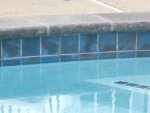Hi,
I had my pool completely redone only 2 summers ago, and now I find that there are crack lines and pieces falling out between the top of the tiles and the bottom (underside) of the coping. Should this be happening so soon? It is mostly around the shallow end, but all around the pool there is a line that has developed at the top of the tiles, whereas before it was this nice seamless joint. I know the warranty on grout and plaster is typically only a few years, but still...is this sort of thing normal? Also, can it be fixed without draining the pool? When I ran into these sorts of problems with my old plaster and tiles, I just used to pull out the loose stuff and put waterproof caulking to fill any holes or gaps. And, again, those problems occurred many years after the original pool was put in. My contractor told me that a renovation can often only go around 10 years, which alone is a rather depressing concept. Also I'm told that some pools 'take' to a renovation better than others. Is this grout problem indicative that I might have one of those pools that is not going to last long following the reno?
Thanks for any advice. I have contacted the company that did the job and sent pictures.
Regards,
Keith
I had my pool completely redone only 2 summers ago, and now I find that there are crack lines and pieces falling out between the top of the tiles and the bottom (underside) of the coping. Should this be happening so soon? It is mostly around the shallow end, but all around the pool there is a line that has developed at the top of the tiles, whereas before it was this nice seamless joint. I know the warranty on grout and plaster is typically only a few years, but still...is this sort of thing normal? Also, can it be fixed without draining the pool? When I ran into these sorts of problems with my old plaster and tiles, I just used to pull out the loose stuff and put waterproof caulking to fill any holes or gaps. And, again, those problems occurred many years after the original pool was put in. My contractor told me that a renovation can often only go around 10 years, which alone is a rather depressing concept. Also I'm told that some pools 'take' to a renovation better than others. Is this grout problem indicative that I might have one of those pools that is not going to last long following the reno?
Thanks for any advice. I have contacted the company that did the job and sent pictures.
Regards,
Keith



